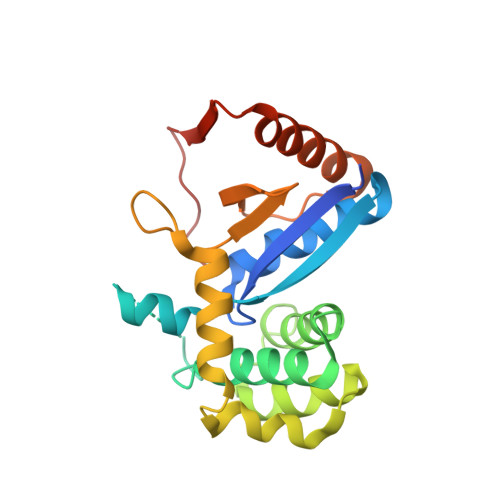Rv2466c mediates the activation of TP053 to kill replicating and non-replicating Mycobacterium tuberculosis.
Albesa-Jove, D., Chiarelli, L.R., Makarov, V., Pasca, M.R., Urresti, S., Mori, G., Salina, E., Vocat, A., Comino, N., Mohorko, E., Ryabova, S., Pfieiffer, B., Lopes Ribeiro, A.L., Rodrigo-Unzueta, A., Tersa, M., Zanoni, G., Buroni, S., Altmann, K.H., Hartkoorn, R.C., Glockshuber, R., Cole, S.T., Riccardi, G., Guerin, M.E.(2014) ACS Chem Biol 9: 1567-1575
- PubMed: 24877756
- DOI: https://doi.org/10.1021/cb500149m
- Primary Citation of Related Structures:
4NXI - PubMed Abstract:
The emergence of multidrug- and extensively drug-resistant strains of Mycobacterium tuberculosis highlights the need to discover new antitubercular agents. Here we describe the synthesis and characterization of a new series of thienopyrimidine (TP) compounds that kill both replicating and non-replicating M. tuberculosis. The strategy to determine the mechanism of action of these TP derivatives was to generate resistant mutants to the most effective compound TP053 and to isolate the genetic mutation responsible for this phenotype. The only non-synonymous mutation found was a g83c transition in the Rv2466c gene, resulting in the replacement of tryptophan 28 by a serine. The Rv2466c overexpression increased the sensitivity of M. tuberculosis wild-type and resistant mutant strains to TP053, indicating that TP053 is a prodrug activated by Rv2466c. Biochemical studies performed with purified Rv2466c demonstrated that only the reduced form of Rv2466c can activate TP053. The 1.7 Å resolution crystal structure of the reduced form of Rv2466c, a protein whose expression is transcriptionally regulated during the oxidative stress response, revealed a unique homodimer in which a β-strand is swapped between the thioredoxin domains of each subunit. A pronounced groove harboring the unusual active-site motif CPWC might account for the uncommon reactivity profile of the protein. The mutation of Trp28Ser clearly predicts structural defects in the thioredoxin fold, including the destabilization of the dimerization core and the CPWC motif, likely impairing the activity of Rv2466c against TP053. Altogether our experimental data provide insights into the molecular mechanism underlying the anti-mycobacterial activity of TP-based compounds, paving the way for future drug development programmes.
- Unidad de Biofísica, Centro Mixto Consejo Superior de Investigaciones Científicas-Universidad del País Vasco/Euskal Herriko Unibertsitatea (CSIC, UPV/EHU), Leioa, Bizkaia 48940, Spain.
Organizational Affiliation:


















